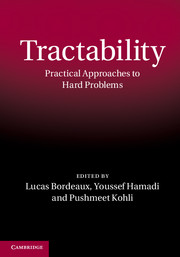2 - Perfect Graphs and Graphical Modeling
from Part 1 - Graphical Structure
Published online by Cambridge University Press: 05 February 2014
Summary
This chapter reduces the inference problem in probabilistic graphical models to an equivalent maximum weight stable set problem on a graph. We discuss methods for recognizing when the latter problem can be solved efficiently by appealing to perfect graph theory. Furthermore, practical solvers based on convex programming and message-passing are presented.
Tractability is the study of computational tasks with the goal of identifying which problem classes are tractable or, in other words, efficiently solvable. The class of tractable problems is traditionally assumed to be solvable in polynomial time by a deterministic Turing machine and is denoted by P.The class contains many natural tasks such as sorting a set of numbers, linear programming (the decision version), determining if a number is prime, and finding a maximum weight matching. Many interesting problems, however, lie in another class that generalizes P and is known as NP: the class of languages decidable in polynomial time on a non-deterministic Turing machine. We trivially have that P isasubset of NP (many researchers also believe that it is a strict subset). It is believed that many problems in the class NP are, in the worst case, intractable and do not admit efficient inference. Problems such as maximum stable set, the traveling salesman problem and graph coloring are known to be NP-hard (at least as hard as the hardest problems in NP). It is, therefore, widely suspected that there are no polynomial-time algorithms for NP-hard problems.
- Type
- Chapter
- Information
- TractabilityPractical Approaches to Hard Problems, pp. 39 - 68Publisher: Cambridge University PressPrint publication year: 2014



